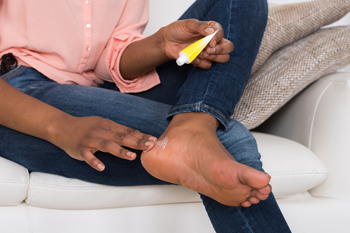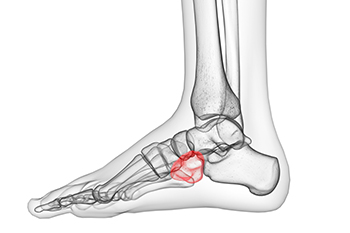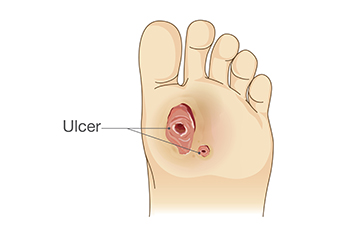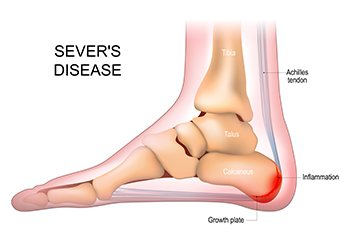Items filtered by date: May 2024
Causes And Treatment Of Cracked Heels

Cracked heels often stem from various factors, including obesity, wearing ill-fitting shoes, prolonged standing, and dry skin. When the skin on your feet lacks moisture and becomes stiff, it is more susceptible to cracking, especially under pressure while standing or walking. Certain conditions, such as diabetes, psoriasis, and flat feet, can further dry out the skin and increase the risk of cracked heels or painful fissures. Preventative measures include moisturizing regularly, avoiding harsh soaps, and opting for closed-heeled shoes with ample cushioning. Wearing cotton socks can also help to reduce friction. Mild relief typically involves moisturizers containing ingredients like urea or hyaluronic acid, which help retain moisture and soften the skin. While mild cases can often be managed at home, it is important to see a podiatrist if heel cracks are associated with a medical condition or if they have become infected. Seeking professional advice ensures a proper diagnosis and treatment, leading to quicker healing and long-term foot health. If cracked and painful heels are causing you discomfort, it is suggested that you schedule an appointment with a podiatrist.
If the skin on your feet starts to crack, you may want to see a podiatrist to find treatment. If you have any concerns, contact Michael Bess, DPM from Florida. Our podiatrist can provide the care you need to keep you pain-free and on your feet.
Cracked Heels
It is important to moisturize your cracked heels in order to prevent pain, bleeding, and infection. The reason cracked heels form is because the skin on the foot is too dry to support the immense pressure placed on them. When the foot expands, the dry skin on the foot begins to split.
Ways to Help Heal Them
- Invest in a good foot cream
- Try Using Petroleum Jelly
- Ease up on Soaps
- Drink Plenty of Water
Ways to Prevent Cracked Heels
- Moisturize After Showering
- Skip a Shower
- Keep Shower Water Lukewarm
- Don’t Scrub Your Feet
If you are unsure how to proceed in treating cracked heels, seek guidance from a podiatrist. Your doctor will help you with any questions or information you may need.
If you have any questions, please feel free to contact our office located in West Palm Beach, FL . We offer the newest diagnostic and treatment technologies for all your foot care needs.
Plantar Warts Can Be Treated!
Cuboid Syndrome and Other Cuboid Injuries
 Cuboid syndrome occurs when the cuboid bone, located on the outer side of the midfoot, partially dislocates. This condition typically results from injury or repetitive strain that disrupts the alignment and stability of the cuboid bone. The hallmark symptom of cuboid syndrome is pain on the lateral side of the foot, especially when weight is placed on the foot or when pushing off the toes. Other symptoms can include tenderness, swelling, and difficulty walking. Athletes or people with poor foot biomechanics are more prone to getting cuboid syndrome. Another type of cuboid injury, cuboid fractures, are less common. Fractures result from direct trauma or severe force to the cuboid bone, leading to more acute and localized pain, significant swelling, and bruising. Both conditions require proper medical assessment and treatment. For cuboid syndrome, treatment might involve various techniques, such as manipulation to realign the bone, taping to stabilize it, and orthotics to correct biomechanical issues. For fractures, immobilization with a cast or boot and possibly surgery may be necessary. A podiatrist, or foot doctor, can diagnose these conditions through clinical evaluation and imaging studies like X-rays. They can also provide the appropriate management techniques to alleviate pain and restore function. If you suspect an injury to the cuboid bone in the foot, it is suggested that you make an appointment with a podiatrist as soon as possible.
Cuboid syndrome occurs when the cuboid bone, located on the outer side of the midfoot, partially dislocates. This condition typically results from injury or repetitive strain that disrupts the alignment and stability of the cuboid bone. The hallmark symptom of cuboid syndrome is pain on the lateral side of the foot, especially when weight is placed on the foot or when pushing off the toes. Other symptoms can include tenderness, swelling, and difficulty walking. Athletes or people with poor foot biomechanics are more prone to getting cuboid syndrome. Another type of cuboid injury, cuboid fractures, are less common. Fractures result from direct trauma or severe force to the cuboid bone, leading to more acute and localized pain, significant swelling, and bruising. Both conditions require proper medical assessment and treatment. For cuboid syndrome, treatment might involve various techniques, such as manipulation to realign the bone, taping to stabilize it, and orthotics to correct biomechanical issues. For fractures, immobilization with a cast or boot and possibly surgery may be necessary. A podiatrist, or foot doctor, can diagnose these conditions through clinical evaluation and imaging studies like X-rays. They can also provide the appropriate management techniques to alleviate pain and restore function. If you suspect an injury to the cuboid bone in the foot, it is suggested that you make an appointment with a podiatrist as soon as possible.
Cuboid syndrome, also known as cuboid subluxation, occurs when the joints and ligaments near the cuboid bone in the foot become torn. If you have cuboid syndrome, consult with Michael Bess, DPM from Florida. Our podiatrist will assess your condition and provide you with quality foot and ankle treatment.
Cuboid syndrome is a common cause of lateral foot pain, which is pain on the outside of the foot. The condition may happen suddenly due to an ankle sprain, or it may develop slowly overtime from repetitive tension through the bone and surrounding structures.
Causes
The most common causes of cuboid syndrome include:
- Injury – The most common cause of this ailment is an ankle sprain.
- Repetitive Strain – Tension placed through the peroneus longus muscle from repetitive activities such as jumping and running may cause excessive traction on the bone causing it to sublux.
- Altered Foot Biomechanics – Most people suffering from cuboid subluxation have flat feet.
Symptoms
A common symptom of cuboid syndrome is pain along the outside of the foot which can be felt in the ankle and toes. This pain may create walking difficulties and may cause those with the condition to walk with a limp.
Diagnosis
Diagnosis of cuboid syndrome is often difficult, and it is often misdiagnosed. X-rays, MRIs and CT scans often fail to properly show the cuboid subluxation. Although there isn’t a specific test used to diagnose cuboid syndrome, your podiatrist will usually check if pain is felt while pressing firmly on the cuboid bone of your foot.
Treatment
Just as the range of causes varies widely, so do treatments. Some more common treatments are ice therapy, rest, exercise, taping, and orthotics.
If you have any questions, please feel free to contact our office located in West Palm Beach, FL . We offer the newest diagnostic and treatment technologies for all your foot care needs.
Facts and Care Guidelines Regarding Diabetic Foot Ulcers

Diabetic foot ulcers, a common complication of diabetes, are open wounds that develop on the feet or lower legs, often due to poor circulation, nerve damage, or trauma. These ulcers can be slow to heal and prone to infection, posing serious risks if left untreated. Proper care is essential for managing diabetic foot ulcers and preventing complications. Begin by keeping the ulcer clean and dry, washing it gently with mild soap and water, and patting it dry with a clean towel. Apply an antibiotic ointment and cover the ulcer with a sterile dressing to protect it from further injury and reduce the risk of infection. Avoid putting weight on the affected foot and wear comfortable, well-fitted shoes to minimize pressure on the ulcer. Regularly monitor the ulcer for signs of infection, such as redness, swelling, or pus. If you are a diabetic and foot ulcers are a problem, it is strongly suggested that you are under the care of a podiatrist who can effectively treat these foot wounds and help you manage your diabetes.
Wound care is an important part in dealing with diabetes. If you have diabetes and a foot wound or would like more information about wound care for diabetics, consult with Michael Bess, DPM from Florida. Our podiatrist will assess your condition and provide you with quality foot and ankle treatment.
What Is Wound Care?
Wound care is the practice of taking proper care of a wound. This can range from the smallest to the largest of wounds. While everyone can benefit from proper wound care, it is much more important for diabetics. Diabetics often suffer from poor blood circulation which causes wounds to heal much slower than they would in a non-diabetic.
What Is the Importance of Wound Care?
While it may not seem apparent with small ulcers on the foot, for diabetics, any size ulcer can become infected. Diabetics often also suffer from neuropathy, or nerve loss. This means they might not even feel when they have an ulcer on their foot. If the wound becomes severely infected, amputation may be necessary. Therefore, it is of the upmost importance to properly care for any and all foot wounds.
How to Care for Wounds
The best way to care for foot wounds is to prevent them. For diabetics, this means daily inspections of the feet for any signs of abnormalities or ulcers. It is also recommended to see a podiatrist several times a year for a foot inspection. If you do have an ulcer, run the wound under water to clear dirt from the wound; then apply antibiotic ointment to the wound and cover with a bandage. Bandages should be changed daily and keeping pressure off the wound is smart. It is advised to see a podiatrist, who can keep an eye on it.
If you have any questions, please feel free to contact our office located in West Palm Beach, FL . We offer the newest diagnostic and treatment technologies for all your foot care needs.
Sever’s Disease and Children’s Heel Pain
 Sever's disease, also known as calcaneal apophysitis, is a common cause of heel pain in growing children and adolescents, especially in those who play sports. This condition occurs when the growth plate in the heel becomes inflamed, often due to repetitive stress from activities like running and jumping. This, combined with the pressure of rapid bone growth during puberty, can create painful heels. The pain may worsen during or after physical activity and include tenderness to the touch. It may also lead to limping, especially after waking up or more intense physical activities. Treatment typically involves rest and various exercises that stretch and strengthen the leg muscles and tendons. Footwear with proper cushioning and support is also suggested to help alleviate symptoms. With appropriate management, symptoms usually resolve with the completion of the growth spurt, as the heel bone matures. If your child has painful heels and you suspect Sever’s disease, it is suggested that you make an appointment with a podiatrist for a diagnosis and management techniques.
Sever's disease, also known as calcaneal apophysitis, is a common cause of heel pain in growing children and adolescents, especially in those who play sports. This condition occurs when the growth plate in the heel becomes inflamed, often due to repetitive stress from activities like running and jumping. This, combined with the pressure of rapid bone growth during puberty, can create painful heels. The pain may worsen during or after physical activity and include tenderness to the touch. It may also lead to limping, especially after waking up or more intense physical activities. Treatment typically involves rest and various exercises that stretch and strengthen the leg muscles and tendons. Footwear with proper cushioning and support is also suggested to help alleviate symptoms. With appropriate management, symptoms usually resolve with the completion of the growth spurt, as the heel bone matures. If your child has painful heels and you suspect Sever’s disease, it is suggested that you make an appointment with a podiatrist for a diagnosis and management techniques.
Sever's disease often occurs in children and teens. If your child is experiencing foot or ankle pain, see Michael Bess, DPM from Florida. Our podiatrist can treat your child’s foot and ankle needs.
Sever’s Disease
Sever’s disease is also known as calcaneal apophysitis, which is a medical condition that causes heel pain I none or both feet. The disease is known to affect children between the ages of 8 and 14.
Sever’s disease occurs when part of the child’s heel known as the growth plate (calcaneal epiphysis) is attached to the Achilles tendon. This area can suffer injury when the muscles and tendons of the growing foot do not keep pace with bone growth. Therefore, the constant pain which one experiences at the back of the heel will make the child unable to put any weight on the heel. The child is then forced to walk on their toes.
Symptoms
Acute pain – Pain associated with Sever’s disease is usually felt in the heel when the child engages in physical activity such as walking, jumping and or running.
Highly active – Children who are very active are among the most susceptible in experiencing Sever’s disease, because of the stress and tension placed on their feet.
If you have any questions, please feel free to contact our office located in West Palm Beach, FL . We offer the newest diagnostic and treatment technologies for all your foot and ankle injuries.

